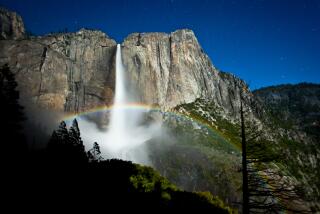A Peak Experience at Foot of Maroon Bells
- Share via
The Maroon Bells are three matching mountains at the 10,000-foot elevation--about four miles up the hill from Aspen Highlands in Colorado. Above the timberline, they are a softened red, the color of corundum or burnt sienna.
As evening climbs the mountains, they are back-lit by the sinking sun, as if there were a spot stage left, lighting the folds and crevices.
My friend from Houston, Jean Erck, and I took our sundown drinks to a spot at the foot of the Maroon Bells and listened to the silence. Sitting on a comfortable rail fence, we looked down on Maroon Lake. It’s blue, but it’s filled by snow water from the Maroon Bells and it spares enough water to ripple down the hill behind Jean’s house in Aspen Highlands and make Maroon Creek.
The only sounds in the evening are the rustle of the wind in the trees, aspen, poplar, fir and pine and the scurrying sound of the small animals off there in the trees.
It’s a spot to heal your city-battered soul. We walked down to the creek and crossed a wooden bridge to a mini-lake--the result of a fine dam a colony of beavers had built.
In such a place, the silence roars in your ears. There is a majesty in a total absence of sound that fills us with awe. Our ears are generally assaulted by so much extraneous noise that we have learned to listen above it. When it goes away, we are tempted to listen to the quiet and say: “What’s that noise?”
Aspen in the summertime is buzzing with bicycle racers, learned or at least noted speakers, and, happily, there is music everywhere. Aspen Music Associates has a famous summer school--offering concerts, master classes. The students are recommended by their coaches and professors at Juilliard and other lofty music schools. The young people play everywhere.
Downtown in the mall, a street closed to automobiles and fronted by shops of all kinds, we sat and had coffee and croissants, while 30 feet away, a group playing flute, cello and violin made sounds as rippling and soothing as Maroon Creek.
There were young musicians in the lobby of the Jerome Hotel, in front of shops, in arcades. The featured artists at the concerts are all notable, at the peak of their arts.
I was pleased to see that the statue of Justice in the front of the courthouse still gazes wide-eyed at her former silver-mining town. Think of what the lady would have missed if she had been wearing a blindfold all these years, especially after Jerome Wheeler built the Wheeler Opera House and brought in the Silver Circle theatrical troupes. Probably Lotta Crabtree wearing her white kid boots and wasp-waisted can-can dress came in from San Francisco. The miners were rolling 100 pounds of ore down the mountainsides wrapped in cowhide.
Justice stands on a ledge about two-thirds up the courthouse, holding her justice scales as if she wondered who had handed them to her. The courthouse is topped by a pyramid painted mint green and trimmed with strawberry stone.
The forest rangers stop traffic from 9 a.m. to 5 p.m., because too much smog was beginning to dry up the trees, causing them to shed their leaves.
The weekend of the harmonic convergence, a couple of hundred people went to the foot of the Maroon Bells. A forest ranger told us he asked them to gather at another area at the mountain. He said: “How can they experience a harmonic convergence if they can’t even keep from crushing a meadow?”
Aspen was a silver boom town from 1890 until 1893 when 1,200 people and six newspapers left, because the government canceled the silver standard.
The town of Aspen snoozed until the 1930s when ski experts established the Highland-Bavarian ski area at Ashcroft. Now, it’s a green-and-gold town full of Victorian houses and, in the winter, skiers--when the houses are frosted with snow.
All the seasons have their own enchantment. Best of all is seeing the sun glance over the Maroon Bells in the fresh cool early evening.
More to Read
Sign up for The Wild
We’ll help you find the best places to hike, bike and run, as well as the perfect silent spots for meditation and yoga.
You may occasionally receive promotional content from the Los Angeles Times.




